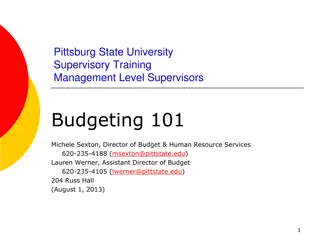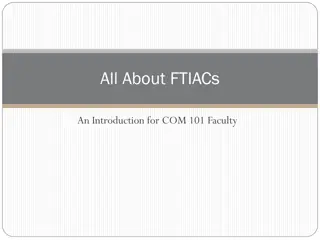BroncoBudget 101
Depicting the financial trajectory of BroncoBudget over Fiscal Years 2018 to 2020, this data-driven narrative delves into budget allocations, revenue assessment, and enrollment impact. Explore how shifting enrollment figures influence budgetary decisions and the color-coded representation of financial increments.
Download Presentation

Please find below an Image/Link to download the presentation.
The content on the website is provided AS IS for your information and personal use only. It may not be sold, licensed, or shared on other websites without obtaining consent from the author.If you encounter any issues during the download, it is possible that the publisher has removed the file from their server.
You are allowed to download the files provided on this website for personal or commercial use, subject to the condition that they are used lawfully. All files are the property of their respective owners.
The content on the website is provided AS IS for your information and personal use only. It may not be sold, licensed, or shared on other websites without obtaining consent from the author.
E N D
Presentation Transcript
BroncoBudget 101 Part I. BB is not revenue
FY18 COAS Budget $50.0 $45.0 FY18 = Fiscal Year 2017-18 Same as Academic Year 2017-18 COAS appropriated budget in $Million. Actual = $41,632,403 $41.6 $40.0 $35.0 $30.0 $25.0 $20.0 $15.0 $10.0 $5.0 $- FY18
FY19 COAS Budget $50.0 Typical incremental budgeting Start with FY18 budget, then: CEC Fringe changes New initiatives Other permanent adjustments Actual = $42,968,281 $43.0 $41.6 $40.0 $30.0 $20.0 $10.0 $- FY18 FY19
BB Begins FY18 data . SCH (Student Credit Hours) Majors (undergrad only) Degrees granted (undergrad only) FY18 Count BB Value SCH 192,440 $ 25.8 M Majors 4,987 $ 4.0 M Degrees 1,017 $ 2.2 M $ 32.0 M Determine FY19 targets Which impact FY20 budget
The Color of Money $50.0 $50.0 $43.0 $43.0 $41.6 $41.6 $40.0 $40.0 $11.0 $30.0 $30.0 $20.0 $20.0 $32.0 $10.0 $10.0 $- $- FY18 FY19 FY18 FY19 BroncoBucks Subvention
FY20 Increment FY19 Actual < FY19 Target Lost 1,500 SCH Lost 190 Majors Budget office ignored degrees FY20 Increment is negative Total cut = ($ 350,000) FY19 Target FY19 Actual FY20 Increment SCH 192,440 190,944 ($ 200,000) Majors 4,987 4,799 ($ 150,000) Degrees 1,071 1,071 0 ($ 350,000)
FY20 with BB / FY20 no BB $50.0 $50.0 $45.3 $44.9 $43.0 $43.0 $41.6 $41.6 $40.0 $40.0 $13.3 $11.0 $30.0 $30.0 $20.0 $20.0 $32.0 $31.7 $10.0 $10.0 $- $- FY18 FY19 FY20 FY18 FY19 FY20 BroncoBucks Subvention
Example: Not Revenue John Doe is a lecturer in the Dept of Basket Weaving. He teaches 8 sections of BW101, 3 credits, each with 25 students. Total SCH: 8 x 3 x 25 = 600 BB Value: 600 x 130 = $78,000 Q: How much revenue did John generate? A: None. John contributed 600 SCH ($78K) towards the total COAS obligation of $32M
Recap Bronco Budget is not revenue Bronco Budget splits a normal budget into two colors One color increments normally The other increments based on enrollment Enrollment > target, increment up Enrollment < target, increment down The initial baseline is a permanent obligation If you think BB will pay for it, you are probably wrong.
BroncoBudget 101 Part II. BB in departments
General Principles BB does not operate at the department level. It only directly affects the College budget. COAS may pass some effects through to departments. Department decision makers should be aware of BB effects at both the college level and as pass through.
Department Responsibilities BB is a permanent obligation on COAS to maintain enrollments. The college relies on departments to: 1. Maintain course capacity at least matching prior enrollments 2. Recruit and retain majors 3. Identify and act on growth opportunities
College Impacts Down Year $50.0 FY20 BB Loss = ($ 350,000) NOT covered by increased subvention. Those increments are already allocated. BB Loss has to come from somewhere COAS has to figure out where $44.9 $43.0 $41.6 $40.0 $13.3 $11.0 $30.0 $20.0 $32.0 $31.7 $10.0 $- FY18 FY19 FY20 BroncoBucks Subvention
Department Impacts Down Year Minimal to None Department level numbers have high variance. (Sustained downward enrollments in a department will lead to a conversation with the Dean.) COAS and the Budget Office can both act as shock absorbers. (As can departments, via carryforward, but as a last resort.) Direct pass through of BB cuts to departments is not viable. If cuts were to happen at department level, they would be cushioned by COAS. Ideally, shock absorbers work and we wait for a growth year.
Variance and Volatility BB SCH First Fall-to-Fall $200,000 $150,000 $100,000 $50,000 $- $(50,000) $(100,000) $(150,000) $(200,000)
Department Impacts Growth Year COAS is unable to pass the full amount of BB growth to departments. This is the offset of COAS smoothing variance and cushioning down years. Departments receive new funding to match (at least) the cost of new instruction associated with growth. Growth in majors/degrees is harder to support.
Recap Bronco Budget operates at the College level. Department effects, if any, come from the College. COAS softens impact, smooths variance, and supports new instructional costs. Departments are responsible for maintaining enrollment and acting to keep the college healthy.
BroncoBudget 101 Part III. Actual Numbers
COAS Budget History BB Total Gain = $500,000 COAS pass through for instruction = $1M COAS has absorbed the net loss ($ 500,000) $60.0 $49.0 $46.8 $50.0 $44.9 $43.0 $41.6 $16.5 $12.8 $40.0 $13.3 $11.0 $30.0 $20.0 $34.0 $32.5 $32.0 $31.7 $10.0 BB is not revenue! $- FY18 FY19 BroncoBucks FY20 Subvention FY21 FY22
BB Drivers for COAS Across four years of data: SCH up 7,200. BB = $1M. However Ext Studies FC Requirement All other SCH 6,200 4,100 -5,100 Down 2.5% Majors down 184. BB = ($ 150,000) Down 3% Degrees down 119. BB = ($ 250,000) Down 11%
What Now? Recruit! (COAS Strategic Enrollment and Retention Plan coming.) Retain! (COAS Strategic Enrollment and Retention Plan coming.) Identify and implement growth opportunities. (Call me if you have ideas.) Create a more robust pass-through model (Already in COAS Strategic Plan)























